Mobility and Flexibility for Amputees
This is the second in a series of articles for ADAPTIVE FITBUNCH. I’m intending to cater this article specifically to lower-limb amputees, as well as other adaptive athletes who are lacking lower-limb functionality. I hope to also shed light for able-bodied individuals as well, on what it’s like to train as an adaptive athlete. If you or someone you know is an upper-limb amputee and would like to Guest Post regarding fitness, please reach out to trevor@fitbunch.net – I’d love to turn this into a viable resource for every adaptive athlete!
Amputations come in many different forms. Some people are born with an amputation (“congenital”) – while others have malformations of bone or muscle that would make proper development of the limbs impossible (myself included), and many occur by unfortunate accident or trauma. I have been a bilateral above the knee amputee since 13 months of age, due to “tibial dysplasia” and will be writing from this standpoint. If you are a different sort of amputee, feel free to reach out in the comments below or email me at trevor@fitbunch.net for more hints and tips on enhancing your flexibility
Regardless of the reason your limb(s) were amputated, the importance of maintaining flexibility, mobility, endurance, and strength in the remaining portion of your leg, cannot be overstated. Today’s article will primarily focus on some of the more fundamental mobility and flexibility movements that are worth incorporating into your daily routine as an amputee. Down the road, I will write on the importance of building endurance and strength in your lower limbs. For now though, let’s relax and streeeeetch our legs (and hips, and low backs).
BEFORE STARTING ANY MOVEMENT PROGRAM YOU SHOULD HAVE CLEARANCE FROM A DOCTOR AND/OR PHYSICAL THERAPIST
One piece of equipment that I would definitely recommend acquiring is a foam roller (link is to an Amazon Basics foam roller – there are a lot of other options, the one in the link is just fine – No, Amazon doesn’t pay me). You can also find a roller in the sporting goods/fitness equipment section at pretty much any big-box retailer. We will be using the foam roller for a handful of movements, and while it’s not 100% necessary, it’s great to have and feels fantastic!

Beyond the foam roller, there isn’t any need for other equipment. Some of these movements can be performed either with or without your prosthetics, and some are better suited one way or the other. I’ll be sure to try and show it both ways if applicable.
Quick How-To on Foam Rolling
Foam rollers work off the principle of “self-myofascial release” – I break this down to “Self” as in you’re doing it yourself, “Myo-” is a prefix for muscle, and “Fascia” is the top layer of muscle, “Release” meaning that we are releasing “knots” or, more formally, adhesions. In order to optimally use a foam roller, we must seek out these adhesions and concentrate on them for periods of up to 30 seconds. To get the most out of your time foam rolling, take it slow! A good session should take up to 10 or more minutes, and you can do it at any time! If you’re working out, spend a few minutes on the foam roller beforehand. I’m apt to spending time on my roller at home in front of the TV, as well as on breaks at work.
BEFORE STARTING ANY MOVEMENT PROGRAM YOU SHOULD HAVE CLEARANCE FROM A DOCTOR AND/OR PHYSICAL THERAPIST
For lower limb amputees, arguably the most important muscle groups to mobilize are the hip extensors (glutes and hamstrings – on the backside of your thigh) and the adductor complex (muscles on the inside of the thighs). The lower back is also important, because most amputees will deal with lower back pain at some point or another.
Hip Extensor Muscles – Glutes and Hammies!
The gluteus muscle (maximus, minimus, and medius, if you want to get specific) is the largest and most powerful in the body, and it’s importance is even more elevated for lower limb amputees. Over time, through repeated patterns of movement or injury, compensations are going to develop – muscles become overactive and get “tight,” and require stretching, or become underactive, and need strengthening. As you become more active as an amputee, your glutes and hamstrings are going to become more engaged than they ever have been.
Glutes
For the glutes, there are a number of different methods to getting things loose and mobile, my personal favorite involves using the foam roller.
First and foremost, you can simply “sit” on the roller, and roll back and forth. This is a great starting point, and if you’re super sore, will work just fine. However, in order to get the most out of foam rolling for this particular area, we must actively engage it! This is done by externally rotating the hip of the side that you are working on – an easier cue is to “point your toes” – however, since most of us are lacking in that department, we must think of our nubs as “feet,” If you’re sitting normally, squeeze your buttocks together (think “pinch a coin between your cheeks”) – notice how your legs will point slightly outward? There we go! At this point, you will notice tension in your glutes. Great, now as you’re seated, roll yourself back and forth slowly on the roller. Some spots may be tighter than others, focus on those, allow the roller to apply pressure for 20-30 seconds at a time. You should feel the muscles relaxing a bit. It might hurt a bit at first, and that’s normal. Breathe normally and relax. If the pain is too much at any point, you can revert to sitting normally.
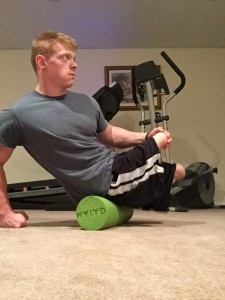
You will notice in the above picture that I am holding onto my leg – I’m pulling it “across the body” with my hand while pushing in the opposite direction with my leg. This is for maximal engagement of the targeted area, and is a bit more of an advanced practice, but definitely works well for really tight muscles.
Hamstrings
The hamstrings make up the backside of your thigh and are also responsible for hip extension (straightening of your legs as you stand up). These are the second group of muscles responsible for movement in above-knee amputees, and work in sync with the glutes. They are also susceptible to pain and tightness, especially if you’re up and moving a good amount. These can be “rolled out” by simply bridging yourself up on the foam roller while focusing on areas of tightness (usually the upper or lower portion of your thighs) as in the photo below
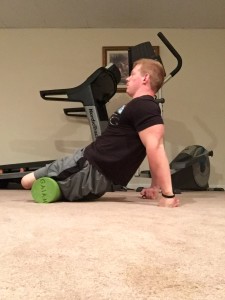
I find that the foam roller doesn’t totally get the job done when it comes to tightness in the back of the legs, so I prefer to use the lying hamstring stretch to totally alleviate this… check it out!
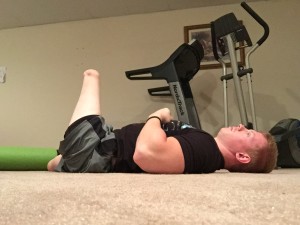
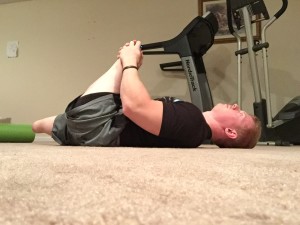
Doing this stretch with each leg a couple of times daily, will greatly enhance your range of motion in your legs, while making you feel better at the same time! It’s a win-win!
Hip Flexors
The hip flexor complex does exactly the opposite of the hip extensor group, brings the lower body towards the upper body. To be specific, the hip flexors include muscles called the psoas, iliacus, and rectus femoris – however, for our purposes, we’ll refer to them collectively as the hip flexors. These are frequently very tight and overactive on amputees, particularly due to the amount of time spent seated (especially if you have a job that requires you to remain seated for long durations, or are still in a wheelchair) – beware of tight hip flexors, as they can lead to immense lower back pain! It’s especially important to keep these mobile and flexible.
The hip flexors are an excellent muscle group to mobilize because they’re incredibly easy to “feel” and the difference that’s made by stretching them is easily realized in daily life, as you’ll experience less lower back pain, and walking will be made much easier!
One of my favorite “classic” stretches for the hip flexors is the “upward facing dog” yoga pose, pictured below. We’ll initiate this movement by laying on our stomachs and slowly walking ourselves into an upright posture using the arms – it’s important to keep tension on the front side of your thighs, so push your pelvis towards the ground.
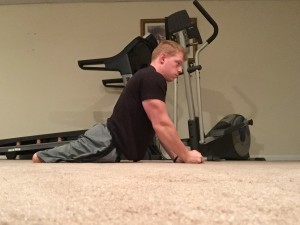
Holding this position for up to 30 seconds at a time is a great method to relaxing the hip flexors, especially for newer amputees who may not be flexible enough to work into the next position. You can perform this with your prosthetics on, but it’s much more comfortable to do so with them off – same goes for the next movement.
My next favorite hip flexor stretch also functions as a hamstring stretch, and is a phenomenal progression from the upward-facing dog – THE SPLITS.
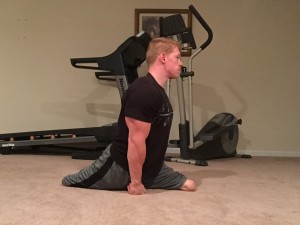
You’ll feel the back side (hamstring) of the front leg being stretched, as well as the front side (hip flexor) of the back leg being stretched – if you can hold this for 20-30 seconds, great!
Now, lets move on to the inner thighs…
Adductors
The adductors are a group of muscles that make up the “groin” or upper-inside thighs – these muscles get tight in most individuals, even those who aren’t amputees. The adductors are named thusly, because they are the muscles responsible for “adduction” (bringing towards the body) of the legs. They become tight as a result of sitting too much, particularly with the legs together.
You can foam roll the adductor muscle group by placing the foam roller on the upper portion of the inside thigh. If you can, utilize your upper body and other leg for some balance.
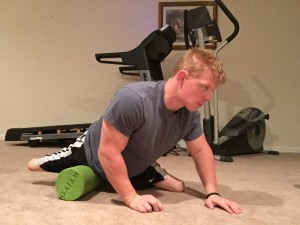
Since targeting the adductors with the foam roller can be difficult, and more of a task than a pleasure, I recommend also trying out the seated adductor stretch, pictured below.
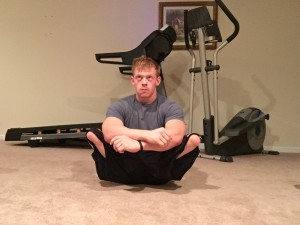

Holding the seated adductor stretch for a period of 20-30 seconds will do wonders for loosening up the inner thighs! From there you can progress into yet another version of the splits!
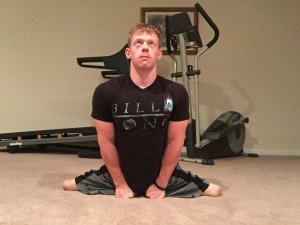
Getting into this variety of split is arguably more difficult than the preceding stretches, so it’s definitely something to work your way up to. Be careful not to progress yourself too soon! You don’t have to be totally on the ground for this to work, just make sure to avoid causing any lower back tension by keeping your core tight!
Either of these stretches is possible with sockets/prosthetics on, but you’d be ill advised to try it, as your range of motion would be limited.
After stretching the adductors, we can move up and into the lower back…
Lower Back
The lower back is a source of much anguish for many people, not just amputees. This is commonly due to the sedentary nature of our society (office jobs, too much time sitting at home, etc) but for amputees the cause can be quite different. Due to our amputations, our weight distribution is different than that of our able-bodied friends – more weight sits on our hips and without the core strength to compensate, our lower back will take the brunt. This is why core strength is paramount for individuals with amputations, but building that is another article in itself (hint hint).
It’s important to consistently keep your lower back both strong and mobile through a variety of different stretches and foam rolling techniques.
My favorite bodyweight stretch for the lower back is the “egg stretch” – aptly named by my good friend and mentor Cameron Clapp – this can be accomplished by pulling one, or both, of your legs towards your chest, while pulling your butt off the ground
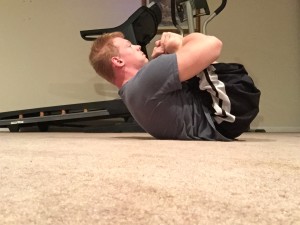
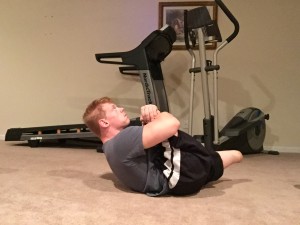
Foam rolling/SMR works really well for the low back as well, and it feels GREAT – simple as placing the foam roller under your lower back and rolling back and forth. This is a movement that works best, in my opinion with prosthetics on, but the benefits can be felt either way.
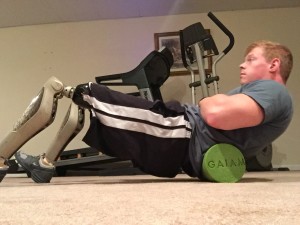
Take your time with this one. Your back may pop at some points, but this is not a bad thing (as long as it doesn’t hurt!). Spend 20-30 seconds slowly rolling up and down your lower back.
Another one of my favorite classic “feel good” stretches for the lower back is the simple Sit-and-Reach – Start by sitting upright, with your legs apart, pointing opposite directions. Hands together, keep your stomach tight (brace like someone is going to punch you) and lean forward, reaching as far as you can.
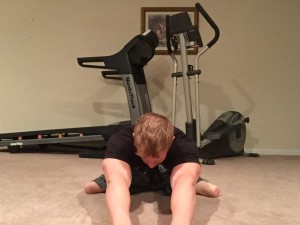
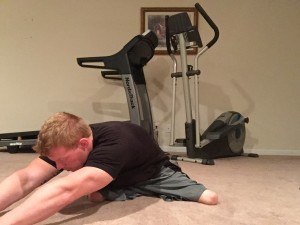
Placing these stretches in your daily routine will aid in your mobility leaps and bounds.
Putting it all together
All of this may seem like a whole lot to digest, initially. And no denying, this is a behemoth of an article – I’m glad you’ve made it this far! While this all might seem like a lot, it really isn’t. Spend about an a half hour or so the first time you try these, getting the movements down, learning more about how they feel when you do them. These ten movements will help you regain more mobility and flexibility as an amputee, which will make life tons easier!- and if you can spend 15 minutes a day in front of the TV, computer, or on the couch, there is absolutely no doubt in my mind that you can incorporate these movements into your daily routines. You won’t regret it!
Now, get out there, and get mobile!
